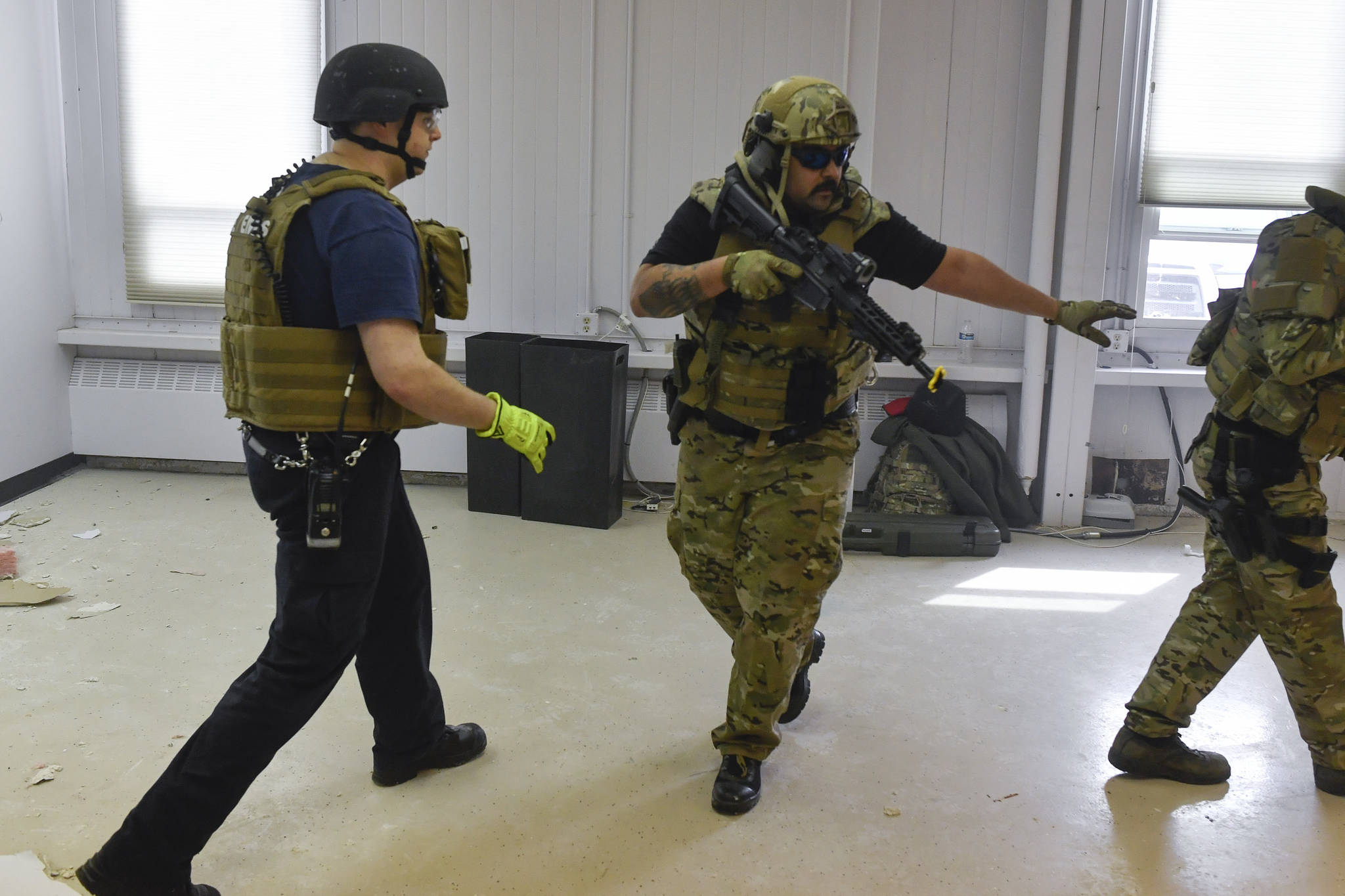The circle of police officers and firefighters stood in a room that they had just torn apart.
A human-sized hole had been ripped through the wall, and pink insulation spilled out. Dust hung in the air from a flash-bang grenade, stinging the eyes and nostrils. Juneau Police Department Sgt. Brian Dallas turned to Capital City Fire/Rescue Engineer Brent Clancy.
“Was the flash-bang loud?” Dallas asked.
“Yeah,” Clancy said, smiling and putting his fingers to his ears. “I had my fingers in my ears.”
“Did you feel it?” JPD Officer Don Ward asked.
Clancy nodded his head.
“It lifted my hat up a little bit,” Clancy said, getting a few laughs out of the camouflage-clad officers.
Tuesday was all about officers and firefighters learning from each other, as JPD’s SWAT team and CCFR responders got together to simulate various emergency situations. They were in the former Public Safety Building, which the City and Borough of Juneau is planning on demolishing, according to a CBJ release Tuesday. That demolition process, which will be done in phases, begins this week.
Dallas said that whenever they hear that a building is going to be torn down, JPD officials try to conduct training exercises in the building where they can cause some damage. For eight hours Tuesday (with a lunch break), the officers and firefighters simulated drug raids, hostage situations, active shooter situations and more.
“It’s not often that we just get to come in and tear apart a building, especially for the new folks,” Clancy, who was the head officer for CCFR in the drills, said. “We have a lot of new folks on staff, and (it’s valuable) just to get them to be able to come in and handle the tools and break doors down.”
[Has Juneau’s crime wave peaked?]
Though most people think of these situations as only involving police or Alaska State Troopers, CCFR is also involved in SWAT activities. For the past two or three years, Dallas and Clancy said, CCFR has carried bulletproof vests and equipment for active shooter situations.
Dallas said that in emergency situations where there is both an active threat and a chance of people in the building being seriously hurt, officers have to prioritize the active threat. Meanwhile, fire department personnel who might be able to treat the injured people are stuck outside waiting for the officers to secure the area.
“In active shooter situation, the police department is tasked with different things such as trying to stop the active killing that’s taking place, so sometimes we have to step past victims, which is contradictory to what our mission is,” Dallas said. “We want to save lives, but we’re trying to save lives as the active part is still going on.”
Across the country, law enforcement agencies are trying to get fire personnel better trained to enter a “hot zone,” where there is still an active threat. During the drill Tuesday afternoon, officers were escorting Kevlar-clad CCFR personnel through a simulated hot zone for them to treat a victim.
Clancy said it was helpful to see how coordinated the SWAT team’s operations were, that they had closely coordinated plans and maneuvers instead of simply “running into a building with their guns drawn.”
Dallas said they learned quite a bit from CCFR personnel, whom he called “experts on breaching doors.” Just like officers look to break down doors quickly to get to their target inside a building, he said, firefighters have to break down doors or windows to get victims of a fire out of a burning building.
“Some of the objectives are slightly different, but they’re trying to save lives as well,” Dallas said. “With a fire, once it starts spreading, it goes fast. They really try to make entry quickly to save anybody who might be inside. Learning from them, their failures and successes, is invaluable.”
[Video: How to get out after falling through the ice]
Property’s future yet to be determined
The CBJ, working with Coogan Construction, will begin demolishing the 1970s-era building this week. The demolition will be done in multiple phases, according to the CBJ press release.
The building has “severe structural problems,” the CBJ release stated.
Once the building is down, the city will put up a temporary parking lot (with 60 spaces) while a long-term design for the Willoughby District is worked out. The Alaska Mental Health Trust Authority bought the property last year.
In the coming months, city officials will be developing a plan for the future of its cold weather emergency shelter, which has been set up in the building the past two winters. The shelter hosted 179 people throughout this past winter, according to an earlier CBJ release.
• Contact reporter Alex McCarthy at amccarthy@juneauempire.com. Follow him on Twitter at @akmccarthy.

